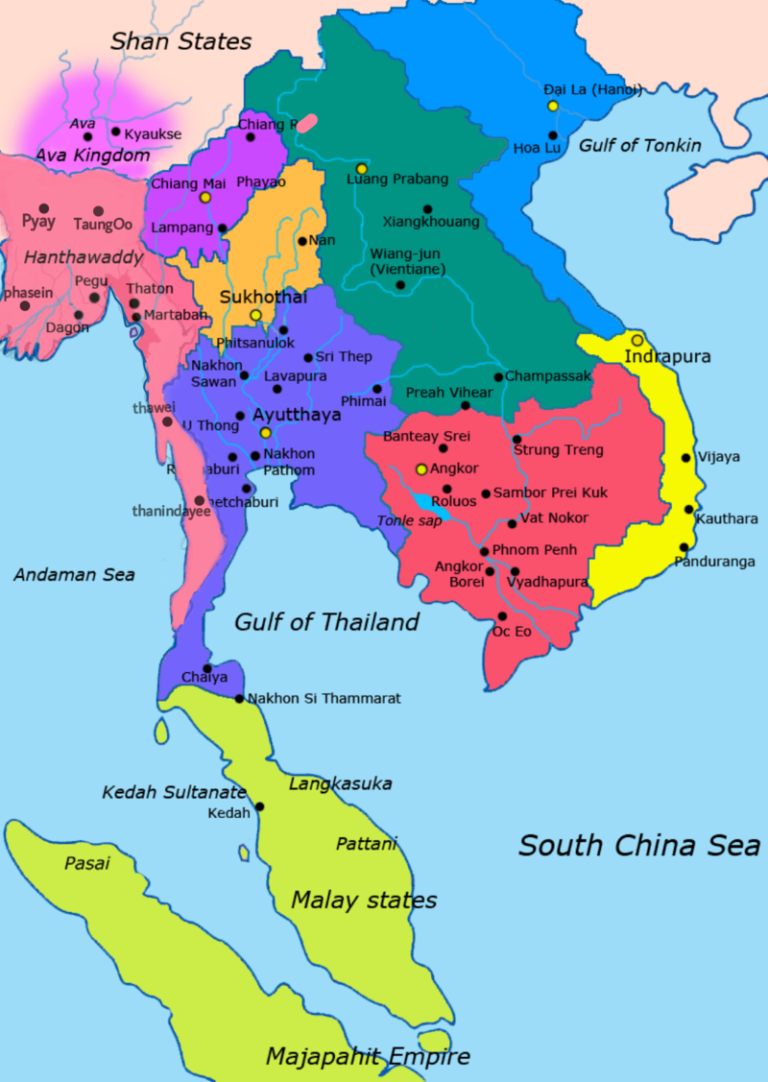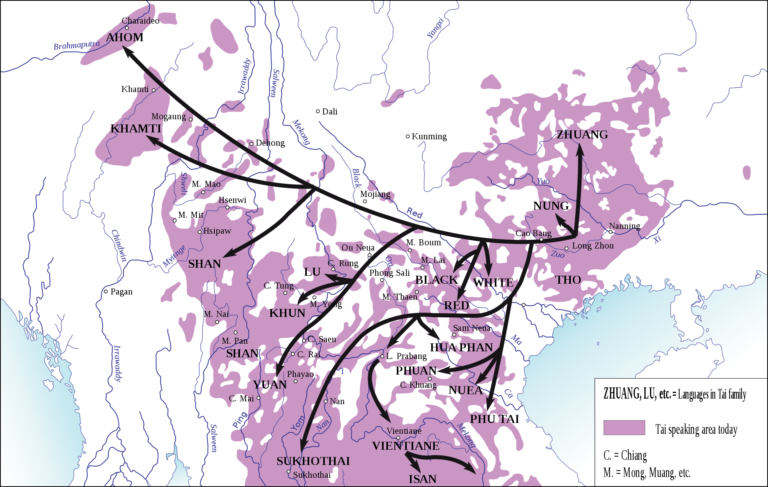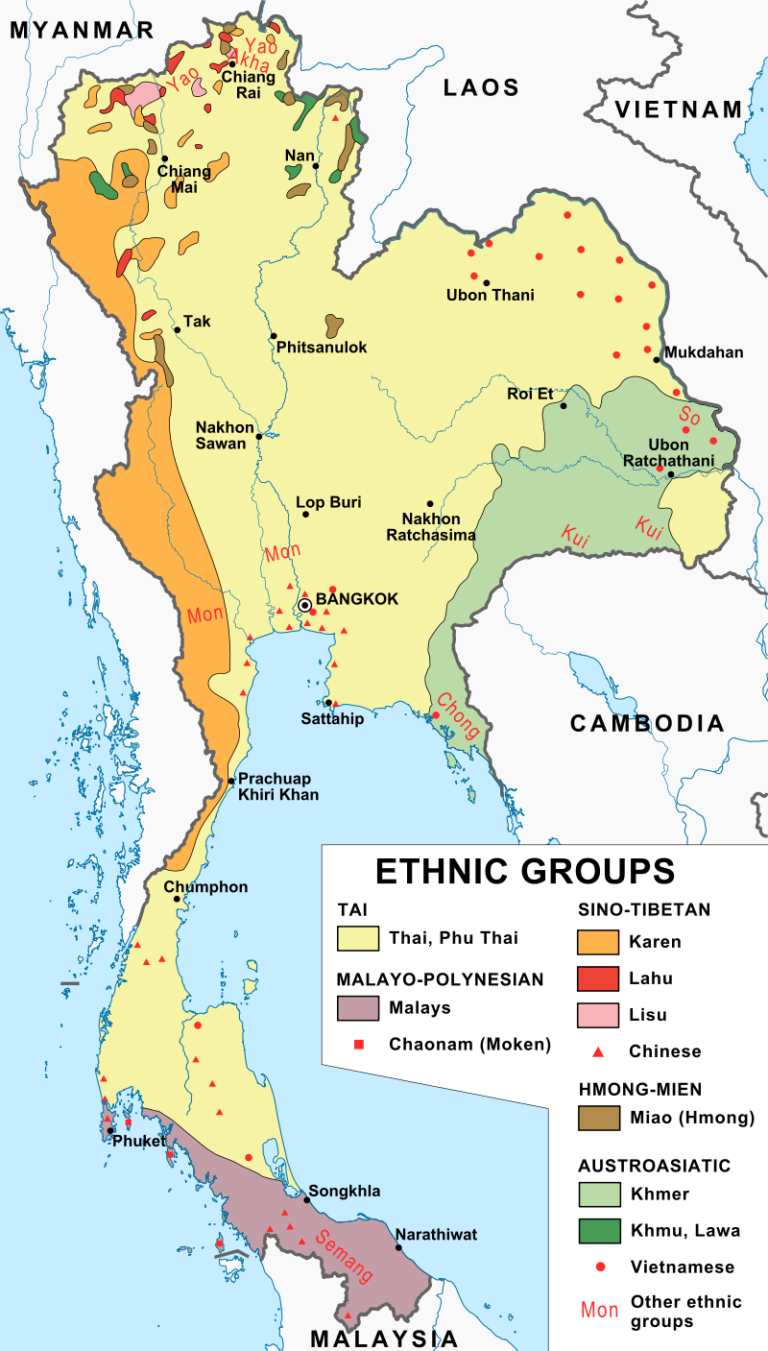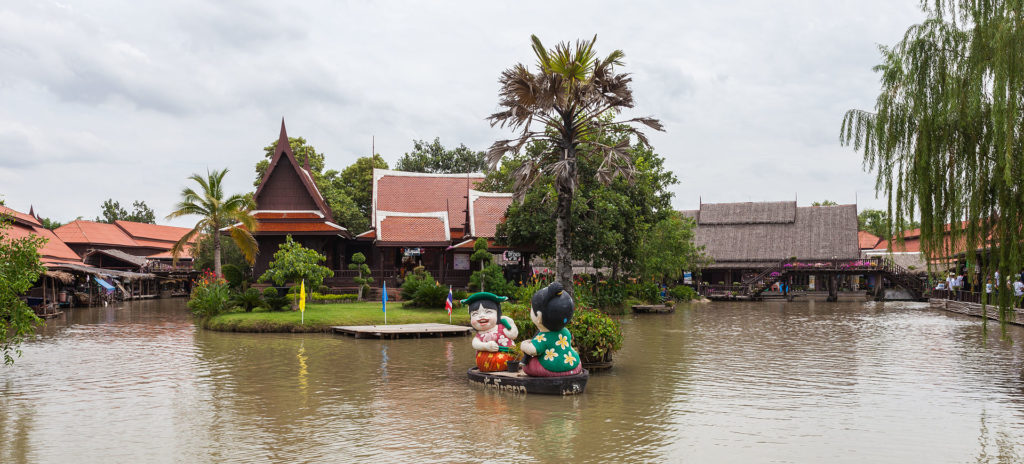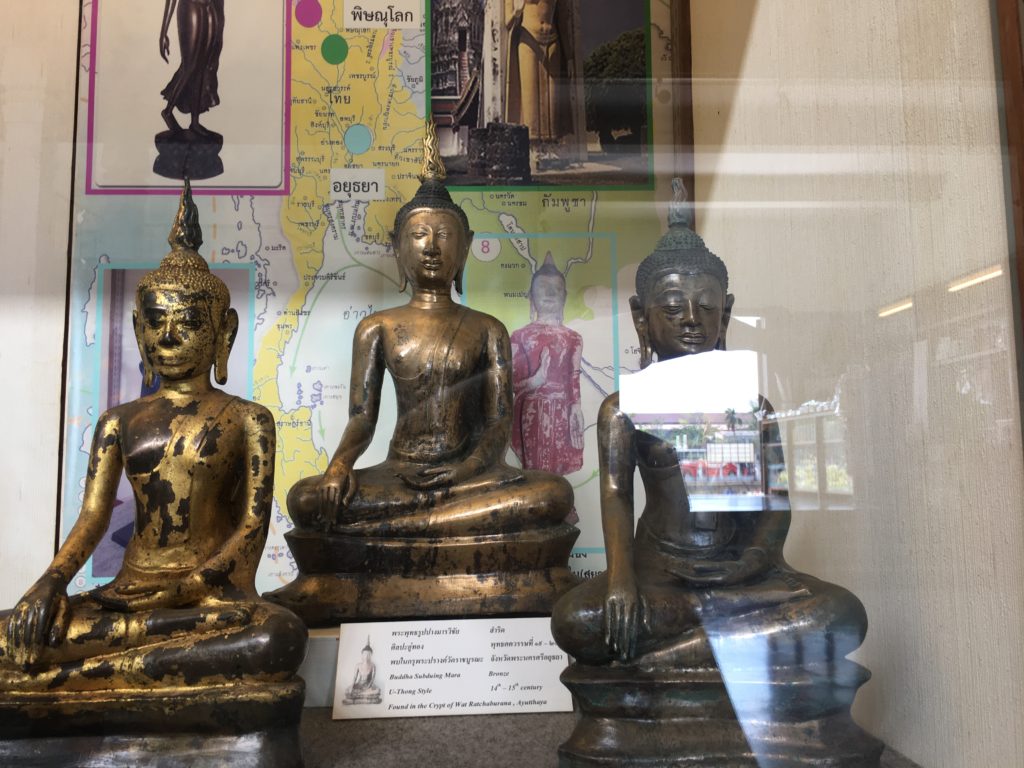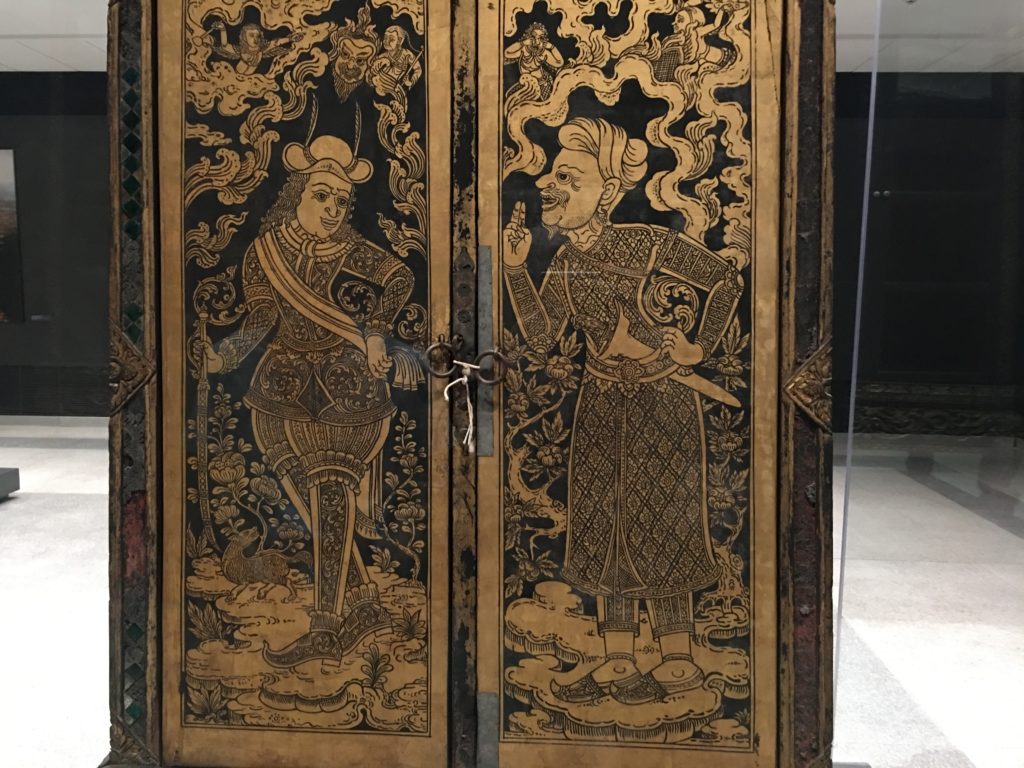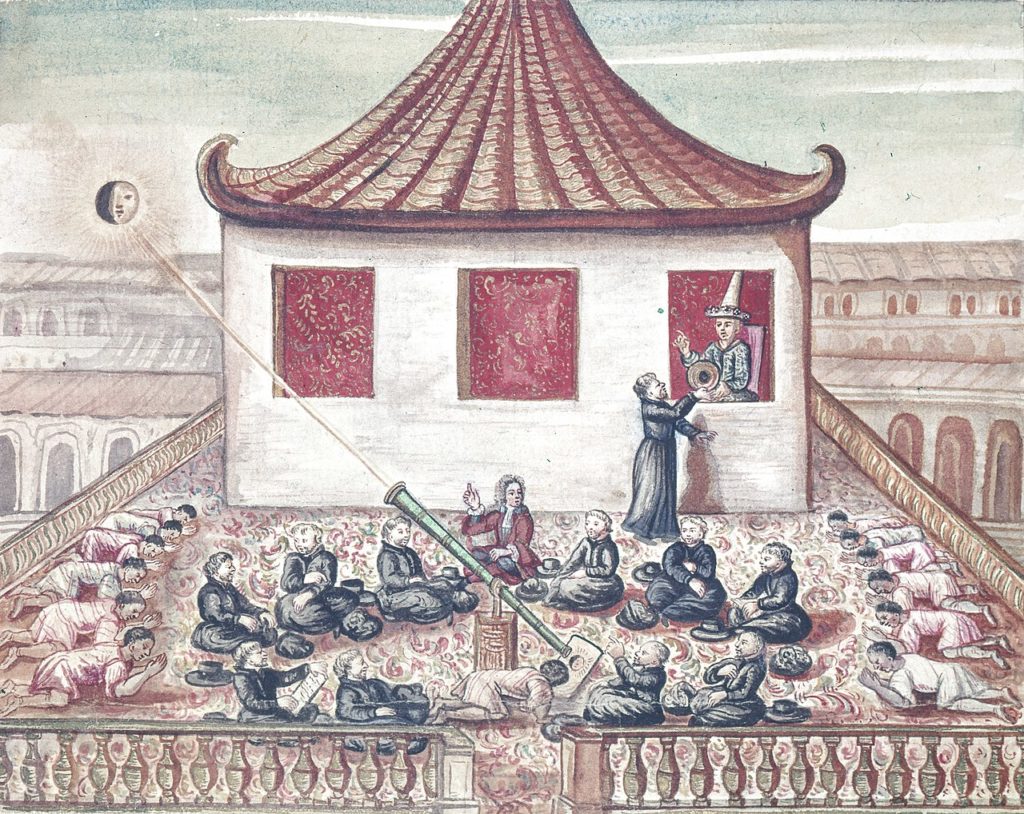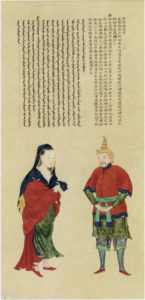Series 3: Ayutthaya
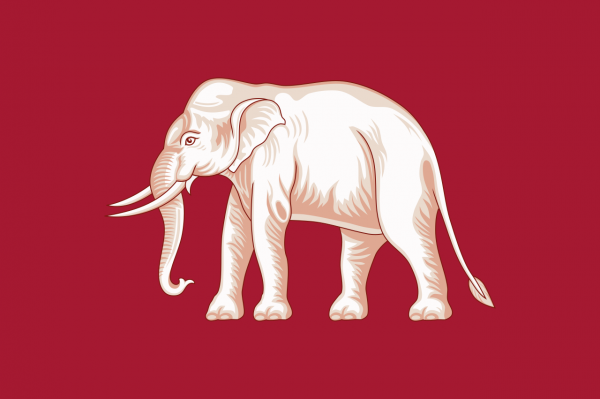
(Flag of Siam under King Mongkut. While this was not the flag of Ayutthaya, but of the Bangkok kingdom in the mid to late 19th century, the symbology is consistent with earlier Ayutthaya, especially the red background and the important symbolism of white elephants)
Founded by Prince U Thong on Friday, March 4th 1351 – just after 9:00 in the morning – the city state of Ayutthaya was initially just another humble port city on the Gulf of Siam. A central trading post for Chinese, Indian and Southeast Asian merchants, the city quickly grew rich. It was only a matter of time until its kings – bold and ambitious – set their eyes on their neighbors. And so began centuries of Ayutthayan dominance of mainland Southeast Asia.
The Thai kingdom of Ayutthaya, the precursor state to modern Thailand, is a fascinating story – of traders, kings, nobles, ministers and monks. In this series, we cover that history from its legendary founding to its terrible destruction by Burmese invaders in 1767.
Maps
What would a history podcast be without plenty of maps? All are licensed under Creative Commons from Wikipedia.
Note that all maps are very speculative. Modern national boundaries are just that: modern. Beyond specific natural frontiers, specific border lines simply did not exist. Thus each map serves to give a general overview of where important things were, and understand relative dynamics between Southeast Asian states.
Ayutthaya’s national “borders” appear to remain mostly stagnant from 1400 to 1750. But that belies the limits of maps as a historical representation. Territory “controlled” by Ayutthaya in the medieval era was only ever loosely under the domain of its kings. But by the city’s destruction in 1767, a system of central government was in place, with governors appointed directly from the capital. A complex bureaucracy managed recruitment and taxation, and provincial independence had been curtailed greatly. Thus Ayutthaya in 1767 was a much more resilient state, despite its other vulnerabilities.

Gallery
All photos courtesy of Wikimedia Commons unless otherwise stated.


Glossary
- Ayutthaya: The name of a city state and the kingdom it ruled, subject of this podcast. Before 1569, the city was called “Ayothaya” after the legendary city of Rama in the Ramayana. But after its sacking, it was renamed “Ayutthaya” – meaning ‘invincible’
- Brahman: A priest in the Hindu tradition. Brahmanism has a long history in Southeast Asia, as ritual officiators and connections to the divine. Brahmans were important in the Khmer Empire, whose royal court was Hindu, but were also included in Ayutthayan court functions, despite being Buddhists.
- Chakri: The title of a major military official in late Ayutthaya. A late holder of this title became King Rama I of the restored Siamese state, giving birth to the modern country of Thailand. The royal family of Thailand today is often known internationally as the “Chakri” dynasty due to its descent from Rama I who held the title.
- Chakravartin/Chakkavatin/Chakkraphat: Variants of the term for “Wheel turning king” a concept from Indian political thought referring to a “universal monarch” who would rule all virtuously and justly. In the 16th century, many kings of Southeast Asia claimed the title, including several in Ayutthaya.
- Chaophraya: The major river of Siam/Thailand, along which Ayutthaya sits. Its many tributaries flow south until they reach the Chaophraya and enter the Gulf of Thailand south of modern Bangkok. Name means “Lord” and thus shares its name with the highest ranking title of nobility in Ayutthaya.
- Chiang Mai: Capital of the rival kingdom of Lan Na in what is today northern Thailand. Founded by the king Mangrai in the 13th century, Chiang Mai and its kings were early enemies of Ayutthaya, vying for dominance of the city states between them. Later, Lan Na fell under the sway of Burma and ceased to play a major role in Ayutthayan history.
- Dvaravati: The name of a civilization in the Chaophraya river valley from about 500 to 1000 AD. Historians once assumed Dvaravati to be a single kingdom, but modern scholars debate this, arguing it was a network of independent city states of Mon culture. Dvaravati left no chronicles, but many inscriptions survive, many of which deal with Buddhism and monasteries instead of political history. Dvaravati style Buddhist relics are common throughout Thailand, and were likely integral in spreading Theravada Buddhism to what is today Thailand.
- Hongsawadi: The early name for the Mon city of Pegu, a major city state on the Andaman Sea. Ayutthayan chronicles referred to the city by this name, though it would eventually be conquered by the Burmese and made into their capital.
- Kalahom: (Pronounced with a “g” instead of a “k”) One of the three highest ranked government offices in Ayutthaya. Effectively commander in chief of the military, the Kalahom shared responsibility for one third of the country alongside the Mahatthai and Phrakhlang ministers.
- Khmer: The name of a language and ethnicity, the dominant group of modern Cambodia. Also the name of the kingdom of classical Cambodia – the Khmer Empire. The Khmer occupied much of modern Thailand until the days of the Tai migrations, and the Tais frequently saw the Khmer as foils to their own way of life, and sought to differentiate their political philosophy and kingship from them. In the 17th century, an Ayutthayan king looked backwards, however, and saw the Khmer Empire as a model to be emulated rather than rejected.
- Khorat: The elevated plateau comprising most of northeastern Thailand today. Name comes from a contraction of Nakhon Ratchasima, the region’s largest city. In the Ayutthayan period, the area was a borderland between Lan Xang, Cambodia and Ayutthaya and was frequently devastated by raids between the three kingdoms.
- Lan Na: Meaning “A million (rice) fields” Lan Na was a kingdom of the Tai Yuan, the people of northern Thailand. Centered on their capital of Chiang Mai, Lan Na was an initial rival of Ayutthaya until its defeat by the Burmese and vassalization by their king in the 16th century.
- Lan Xang: (Pronounced “lahn sahng”) Meaning “million elephants”, Lao kingdom which controlled much of modern Laos and Khorat in the early modern period. At times a rival, other times an ally of Ayutthaya who played a supporting role in Ayutthaya’s history.
- Lao: The dominant ethnic group of modern Laos. The Lao are a Tai people who settled along the northern and southern banks of the Mekong river in Khorat. Historically, the Ayutthayan chronicles referred to many other Tai groups as “Lao” including the Tai Yuan of Lan Na. Lao is closely related to modern Thai, though with significantly less influence from Sanskrit and Pali.
- Lavo/Lopburi: An independent city state which was the first major city to declare independence from the Khmer. According to some accounts of the story, Prince U Thong, founder of Ayutthaya, was son of the city’s king and came to Ayutthaya to found a new capital when a smallpox epidemic broke out in Lavo/Lopburi.
- Mahatthai: Alongside the Kalahom and Phrakhlang, one of the three most important offices in Ayutthayan government. Responsible for civil matters, the Mahatthai shared oversight over one third of the kingdom from the 17th century onwards.
- Mon: An ethnic group living in mainland Southeast Asia for millennia, likely one of the oldest continuous cultures in the region. The Mon once ruled all of the Chaophraya valley prior to the Khmer conquest and subsequent Tai migrations, and many ethnic Mon still inhabit Thailand and Burma.
- Muang: A Tai term for a self-sufficient community. Many Tai towns, villages, cities and kingdoms were known as “Muang” making the term quite versatile. In general, it refers to a self-governing political entity.
- Northern Cities: The Ayutthayan term for the cities and kingdoms lying between Ayutthaya itself and its rival Lan Na. Includes cities like Sukhothai, Phitsanulok, Khamphaeng Phet and others. Ayutthaya and Lan Na vied for dominance over this region until Ayutthaya was able to integrate the region into its growing kingdom, even establishing Phitsanulok as a second capital of the kingdom itself.
- Palace Law: A code of laws relating to all manner of conduct within the royal palace, and among servants and nobles within it. Can be read as a sort of proto-constitution, as it lays the groundwork for the palace and king’s operations and governance. Much of the Palace Law was compiled in the Bangkok era, but dates to as early as the 15th century.
- Phrai: The term for a commoner bound by law to serve the king or nobility. All commoners in Ayutthaya owed some form of corvee or tax to some other nobility, so all were technically “Phrai”, but a great variety existed in degree of obligations.
- Phrai Luang: A Phrai in service of the king. Generally required to offer military service for some period throughout the year. In later centuries Phrai Luang were generally conscripted to do public works or construction projects, rather than military service, leading to a general decline in military quality.
- Phrai Som: A Phrai in service of a noble. Phrai Som’s duties varied wildly, including acting as porters for nobles engaging in trade or cargo transport, owing taxes in the form of cash or kind, or acting as servants to their lord.
- Phrakhlang: The third, and most important, of the three major ministerial offices which include the Kalahom and Mahatthai. The Phrakhlang office takes its name from the royal warehouse, as it was initially created to act as a general overseer of royal trade and trade monopolies. Over time, the Phrakhlang also took on elements of a foreign minister, and eventually morphed into a general civil minister as well, taking charge of a third of the country along with the Kalahom and Mahatthai.
- Ramayana/Ramakien: An Indian epic poem about the avatar of Vishnu, Rama, king of Ayodhya (from which Ayutthaya took its name). The Ramayana was a popular text in the courts of mainland Southeast Asia. The Ramakien is the definitive Thai version compiled in the 19th century, based on the variants popular at the Ayutthayan court a century prior.
- Sakdina: The official system by which social rank was determined, measured in relative fields of rice “Na”. No literal agricultural or land value was assessed, but the relative value played a major role in assessing fines for committing crimes and laying out the hierarchy of ranks for ministers and commoners alike.
- Sangha: The term used in Buddhism for the monastic community who have forsaken worldly affairs in order to achieve Enlightenment.
- Siam: A historical region whose exact boundaries fluctuated with time. In its earliest usage, Siam refers to the geographic area of the Chaophraya River Plain, modern central Thailand. Later, it came to refer to the entire kingdom of Ayutthaya, not just its heartland. Then, after King Rama I restored the monarchy at Bangkok, Siam became the official name for international purposes of his kingdom. The kingdom’s name changed one last time in 1932, where it was officially termed “Thailand” following a military coup and new constitution.
- Sukhothai: An early Tai city in north-central Thailand today. The city of Sukhothai was rich and influential for its time, and its ruling family intermarried into the nascent Ayutthayan ruling dynasty, eventually becoming kings of Ayutthaya themselves in the 16th century, completing a centuries-long process of integration between the kingdoms.
- Tai: A term for the ethnic groups speaking languages in the Tai Kadai language family. The Tais originated in southern China and began migrating into Southeast Asia around 1000 AD. There they established kingdoms of their own along river valleys and between hills, bringing aspects of their language, religion, culture and agriculture to the area. “Tai” includes ethnic groups like Lao, Tai Yuan, Shan and Zhuang, not just “Thais”
- Thai: The term for the Tai peoples living in modern Thailand. The Thai language is one among many Tai tongues, and is differentiated by its adoption of many Sanskrit, Pali and Khmer terms. The two terms “Thai” and “Tai” are pronounced the same. “Thai” identity was created in the 19th and 20th centuries as a project of nation building in the kingdom of Siam, which sought to create a pan-Tai state. Within this podcast, and most historiography, “Thai” refers to the language and people of Ayutthaya (Siamese is a synonym) but NOT Lao, Tai Yuan, Shan or others
- Thammasat: From “thamma” the Pali equivalent of Dharma. A code of religious law common in South and Southeast Asia based around secular applications of religious law.
- Theravada: The form of Buddhism practiced in most of Southeast Asia (outside Vietnam). Distinguished by its relatively conservative interpretation of Buddhist scripture, Theravada claims to be the Buddhism of the ancient Sangha, and does not consider the status of “Bodhisattva” to be one attainable by average folks, does not consider Tantra to be valid scripture, and believes that only monks may achieve enlightenment, not layfolk.
- Three Seals Law: A code of laws compiled by the court of King Rama I in Bangkok. Includes much of the Palace Law of Ayutthaya, the Thammasat, and other legal traditions both new and old. The code is important as much of it is preserved from the Ayutthayan era, and very early on as well, and serves as a valuable primary source for Ayutthaya era kingship and law.
- Yuan: AKA Tai Yuan. The people of modern northern Thailand and of Lan Na. The Ayutthayan chronicles also refer to the Tai Yuan as “Lao”. Nowadays, most Tai Yuan identify simply as “Thai” though they may speak Thai with a northern dialect and have slightly distinct culture as well.
- Xian: The Chinese term for a city state identified by historians as Ayutthaya. Used by historians to refer to the city state of Ayutthaya before its official foundation date in 1351 (which was almost certainly legendary, as the city was inhabited decades before that point)
Noble Ranks of Ayutthaya in Order of Status:*
- Chaophraya
- Phraya, Okya
- Phra, Okphra
- Luang, Okluang
- Muen
- Phan
- Khun
- Nai
*Circa 1700 AD
Bibliography
Baker, Chris; Phongpaichit, Pasuk. A History of Ayutthaya: Siam in the Early Modern World. New York: Cambridge University Press (2017).
Baker, Chris; Phongphaichit, Pasuk. The Palace Law of Ayutthaya and the Thammasat: Law and Kingship in Siam. Ithaca: Cornell University Press (2016).
Baker, Chris; Phongphaichit, Pasuk. Yuan Phai: The Defeat of Lanna, a Fifteenth-Century Thai Epic Poem. Chiang Mai: Silkworm Books (2017).
Baker, Chris; Na Pombejra, Dhiravat; Van Der Kraan, Alfons; Wyatt, David. Van Vliet’s Siam. Chiang Mai: Silkworm Books (2005).
Ed. Breazeale, Kennon. From Japan to Arabia: Ayutthaya’s Maritime Relations with Asia. Bangkok: the Foundation for the Promotion of Social Sciences and Humanities Textbook Project (1999).
Trans. Busyakul, Visudh; Ed. Smithies, Michael. The Diary of Kosa Pan: Thai Ambassador to France, June-July 1686. Chiang Mai: Silkworm Books (2001).
Trans. Cushman, Richard. Ed. Wyatt, David. The Royal Chronicles of Ayutthaya. Bangkok: The Siam Society (2000).
Wyatt, David. Thailand: A Short History. New Haven: Yale University Press (2003).


